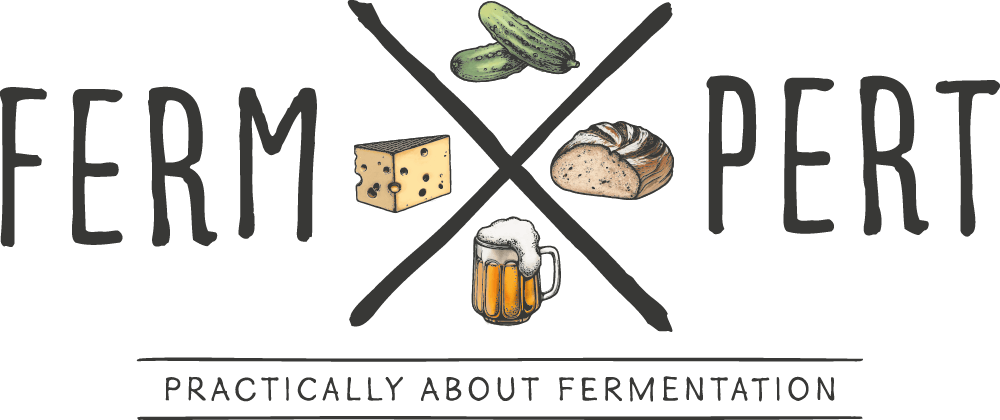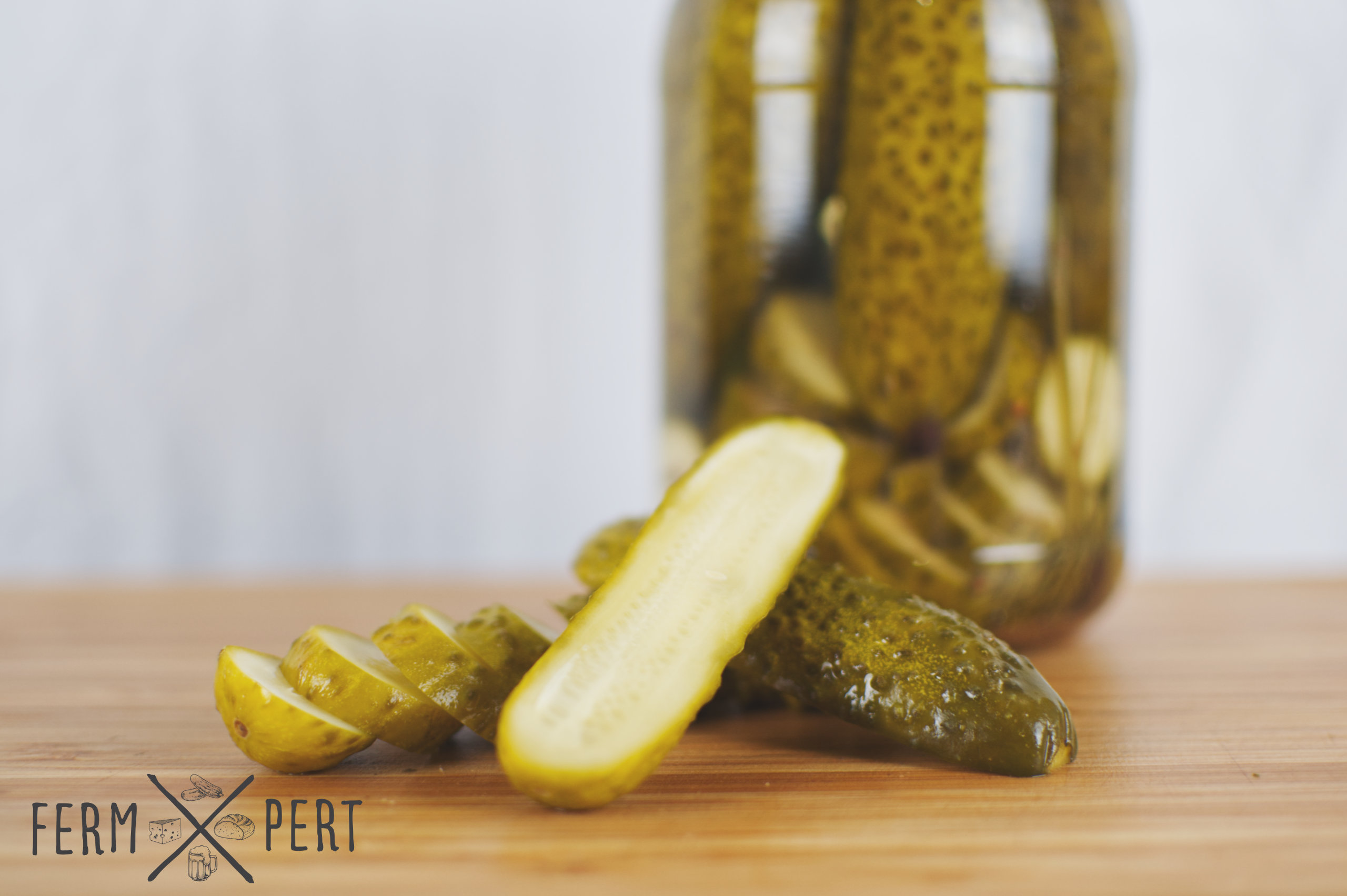One of the ways to preserve gherkins is pickling them in an acetic acid solution. Vinegar pickles can be made in a variety of ways and are made differently in each home. Here’s how I prepare them.
Recipe
I intentionally omit the ingredient quantities. They can be calculated using formulae given in the Additional information section.
- gherkins (pickling cucumbers), washed
- water
- white vinegar
- salt
- sugar
- additions and spices (garlic, dill, bay leaves, allspice, black peppercorns, mustard seeds)
Place the additions and spices in sterilised jars, followed by whole gherkins (alternatively, they can be sliced too).
Pour the calculated amounts of water and vinegar into a pot, add salt and sugar and heat until the solution boils. Pour the hot solution in jars so that it completely covers all ingredients.
Screw on the jar lids and pasteurise the jars for 5-10 minutes.
Additional Information
The acetic acid concentration in the pickling solution can vary a lot, from 0.45% up to as high as 5%. I have never come across higher values. Usually it’s somewhere in the 1.5% range. The most common water to vinegar (10% acidity) ratio in Polish recipes is 1:6 by volume, which results in a 1.67% acetic acid concentration. I prefer to go with 1:7 by volume, yielding a concentration of 1.25% and a much lighter tasting solution.
The water to vinegar ratio can be calculated easily, regardless of vinegar acidity, using the formulae described in the dedicated blog post.
The mass of salt and sugar is just a percentage of the solution’s mass. There’s a bit of room for adjustments according to personal taste. The salt should be somewhere between 1 and 2% of the solution’s mass. I usually go for 2%. Sugar should be around 0.5-4%, the higher values being my personal preference. For instance, if I had 800 grams of pickling solution, I’d go for 16 grams of salt (2%) amd 24-32 grams of sugar (3-4%).
Video Transcription
Pickling cucumbers in vinegar is one of my childhood memories. My parents and my grandparents used to keep jars filled with pickled fruit and vegetables in their basements. Pickled cucumbers were of course among them. That’s exactly what I’m preparing today. A full recipe with additional information can be found on the blog.
I’ll need gherkins, or pickling cucumbers, water and vinegar, as well as a few extra ingredients that will add character to the pickling solution. In my case, it’s garlic, dill, bay leaves, allspice, black peppercorns and mustard seeds. I’ll also use salt and sugar. Everything will go in jars sterilised via boiling.
I begin by placing part of the spices on the jar’s bottom. First goes the bay leaf. Then, the allspice and the peppercorns. I peel and crush a clove of garlic. I also add a bit of dill. I hold off adding the mustard seeds for the time being.
I place the gherkins vertically in the jar, leaving some head room for the pickling solution to completely cover them. If possible, I don’t cut the cucumbers, though sometimes it’s just unavoidable.
While I’m at it, I also prepare a jar of sliced gherkins. The ingredients are the same.
In order to calculate the amount of pickling solution, I fill the jars with water. Next, I pour it off into a bowl and weigh it. This way I know how much solution I need. I still need to calculate the water to vinegar ratio, as well as the amount of salt and sugar.
The acetic acid concentration in the vinegar should be stated on the bottle. In my case it’s 10%. The pickling solution’s concentration should be way lower, though it depends on personal preferences. I like it light, at just 1.25% acidity. Most recipes in Poland give proportions for a concentration of 1.67%. 2% is already a lot, although my great grandfather used to like his gherkins very vinegary and used a 5% solution.
The formulae for calculating all of the ingredient amounts can be found in the blog post.
Before I pour the pickling solution, I add the mustard seeds. They have a tendency to float before they’re fully rehydrated, so I’d probably pour them out along with the water while measuring the amount of pickling solution.
I pour the measured water and vinegar into a pot. I also add salt and sugar. I heat the solution and get it to a boil.
As soon as it boils, I set it aside. I place another pot on the stove, this time with only water. I toss in the jar lids. I boil the water and let the lids sterilise for 10-15 minutes.
I pour the hot solution into the jars. I also add fermentation weights on top. They’re not really required, but since the cucumbers aren’t packed tightly, I like to prevent them from floating.
Then I screw on the lids.
The next step is a short pasteurisation. I place a piece of cloth on the bottom of a pot. It can be anything, really, like a tea towel, but I use a flat cotton nappy. It’s there to separate the glass from the quickly heating pot’s bottom. Otherwise, glass can crack.
I pour hot water into the pot so that it rises to a level below the jar lids. I turn the heat on and wait until the water boils. I simmer the jars for 5-10 minutes.
I place the pasteurised jars on a folded towel, bottom side up. If a jar leaks, I’ll notice. I cover the jars and let them slowly come to room temperature overnight. Then, I transfer them to the basement.
At this stage, the gherkins have already changed colour to an olive green. This is due to the chlorophyll reacting with the acid, losing a magnesium atom and changing into phaeophytin.
The acetic acid influences the aroma and taste of the gherkins, but most importantly, it preserves them. Provided the jars are airtight and the pasteurisation was successful, the gherkins will be good to eat for many months.
The gherkins are ready in a relatively short time, just a few days, maybe a week. The flavour keeps developing for a while though, so it’s a good idea to let them mature for a month.
My gherkins came out very tasty. They’re crunchy, sweet and sour, ideal as a standalone snack, a side dish or a sandwich ingredient. Yum!

